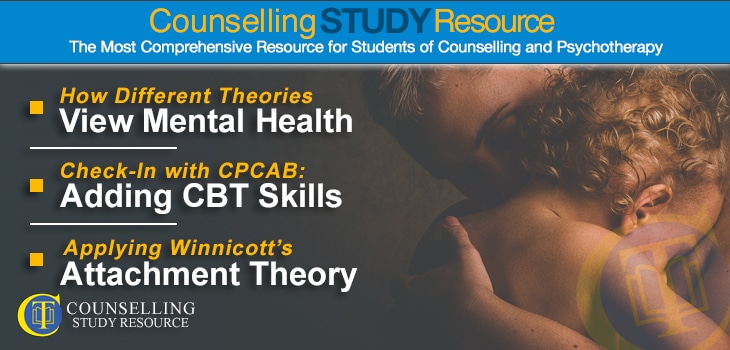152 – Applying Winnicott’s Attachment Theory in Counselling
How Different Theories View Mental Health – Adding CBT Skills to Your Toolbox
In episode 152 of the Counselling Tutor Podcast, Ken Kelly and Rory Lees-Oakes explore how different theories view mental health. ‘Check-In with CPCAB’ then looks at the possible benefits of adding a level 5 CBT diploma to your counselling qualifications. Finally, in ‘Practice Matters’, the presenters look at the use of Winnicott’s attachment theory in counselling.
How Different Theories View Mental Health (starts at 1.35 mins)
Questions on this topic arise regularly in the Counselling Tutor Facebook group – where you can discuss relevant issues with over 31,000 students, practitioners, supervisors and tutors who share an interest in the world of counselling and psychotherapy.
Rory summarises where the three main modalities see the root of mental-health difficulties – e.g. anxiety and depression – arising:
- The psychodynamic approach would say they spring from subconscious processes and sexual drives.
- The person-centred modality would suggest that they stem from incongruence – that is, a mismatch between who a person really is and the face they show the world.
- Cognitive behavioural therapy (CBT) would claim that they derive from irrational (i.e. faulty) thinking.
Rory and Ken look at how each of these modalities might go about treating mental-health difficulties, look at their similarities and differences, talk about the different models that underlie them (medical, philosophical and scientific respectfully), and also touch on transactional analysis (TA).
Rory has written a handout on this topic, which is available here, or through the Handouts Vault and Counselling Study Resource (CSR).
Adding CBT Skills to Your Toolbox (starts at 12.25 mins)
Rory talks to Ray van der Poel (Head of Business and Development) at CPCAB (Counselling & Psychotherapy Central Awarding Body) about its Level 5 Diploma in Cognitive Behavioural Therapeutic Skills & Theory.
Some counsellors find that – having embedded their core modality – they like to add another string to their bow by qualifying in a second modality.
Ray explains the possible benefits of this course, which is 120 Guided learning Hours and 388 hours’ Total Qualification Time, and is typically completed in one academic year. These benefits include:
- increasing possible opportunities for employment in agencies that value CBT skills (e.g. the NHS)
- having a modality that is recognised by the National Institute for Health and Care Excellence (NICE) as an evidence-based treatment for various mental-health conditions
- being able to work with a wider range of clients and client presentations
- having the option to offer clients a choice of modalities
- taking a more holistic approach to client work, encompassing thoughts and behaviours as well as emotions
- learning how to integrate CBT into your person-centred practice, enabling you to combine the strengths of each.
Ray and Rory conclude by stating that for some clients, reality-testing (a technique that is commonly used in CBT and that Rory illustrates with an example from his own practice) is highly valuable.
This segment is sponsored by CPCAB, the UK’s only awarding body run by counsellors for counsellors. You can find out more about CPCAB and the topic discussed today on its website.
Applying Winnicott’s Attachment Theory in Counselling (starts at 28.35 mins)
In this segment of the Counselling Tutor Podcast – aimed at qualified practitioners – Rory and Ken talk about the value of understanding attachment theory, as developed by Donald Winnicott.
Winnicott was a British psychoanalyst and paediatrician who looked in depth at child development and first introduced the idea of the ‘good-enough’ parent.
Understanding Winnicott's attachment theory is important for yourself (in terms of personal development, and seeing more clearly how you relate to others) and for your clients (both adults and children – in terms of how you relate to them, and how they relate to you and to others in their life). It can also help you get the most from supervision.
Rory and Ken talk about how the therapist can take on the role of the ‘good-enough other’ in supporting clients to grow and develop.
Both the CSR (for students) and Counsellor CPD (for qualified counsellors) include a lecture by Rory on Winnicott’s attachment theory, as well as many other resources to support your studies and/or practice.
Free Handout Download
How Counselling Theories View Common Mental Health Issues
